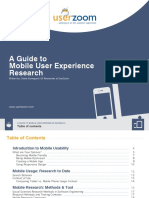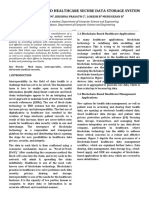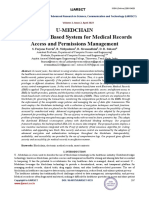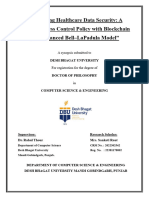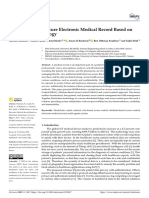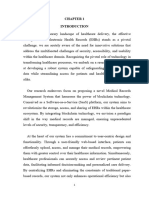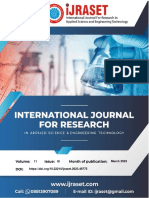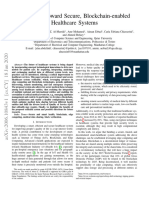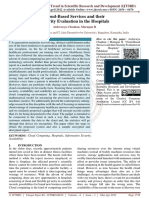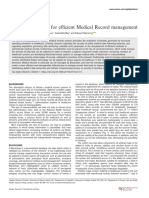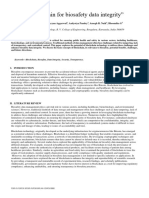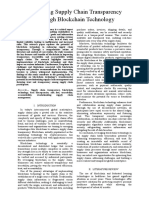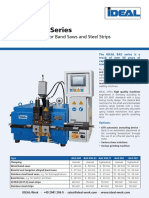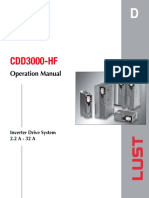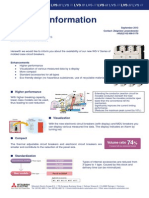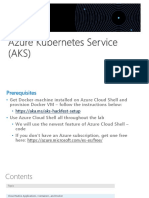Professional Documents
Culture Documents
Blockchain-Enabled Security Solutions For Medical Device Integrity and Provenance in Cloud Environments
Blockchain-Enabled Security Solutions For Medical Device Integrity and Provenance in Cloud Environments
Original Title
Copyright
Available Formats
Share this document
Did you find this document useful?
Is this content inappropriate?
Report this DocumentCopyright:
Available Formats
Blockchain-Enabled Security Solutions For Medical Device Integrity and Provenance in Cloud Environments
Blockchain-Enabled Security Solutions For Medical Device Integrity and Provenance in Cloud Environments
Copyright:
Available Formats
Volume 9, Issue 4, April – 2024 International Journal of Innovative Science and Research Technology
ISSN No:-2456-2165 https://doi.org/10.38124/ijisrt/IJISRT24APR225
Blockchain-Enabled Security Solutions for
Medical Device Integrity and Provenance in
Cloud Environments
1
Omolola Akinola
Dept. of Information Systems and Analysis
Lamar University, Beaumont, Texas, USA
0009-0006-6788-2791
2 3
Akintunde Akinola Bairat Oyekan
Department of Accounting and Finance Dept. of Mathematics
Ekiti State University Lamar University Beaumont, Texas, USA
4
Omowunmi Oyerinde
MIS Lamar University Beaumont, Texas
5 6
Halimat Folashade Adebiyi Busola Sulaimon
Dept. of Business Technology Dept of Industrial and System Engineering
Federal University of Technology Minna Lamar University Beaumont, Texas USA
Abstract:- The current period of medicine using digital implementation of smart contracts, cryptocurrency
technology for patient care presents a new level of processes, and the confidentiality and privacy of data, can
integration of monitoring devices with the cloud be the answer which make up the practice of secure data
computing environment that enables the collection, sharing, data accessing and complying with regulations.
storage and access to data in ways that were never The journal creates a modular system combining Medical
possible earlier. As the obvious part of this development, devices, a cloud platform, and Blockchain solution. The
it is worth noting that the objective of such innovation is architecture is intended to display the blockchain
mostly on the integrity of data, provenance and security. network's essential components, data validation and
Data integrity from as well as security of the Internet access control, and secure data storage mechanisms.
connected healthcare devices should be assured in the first Furthermore, the recommended solution implies state-of-
place to keep patient safety and protect data privacy along the-art security tools, such as data encryption, access
with improve data-based decision-making. The control, and abidance by regulatory systems, including
centralized system and crowded nature of the current HIPAA and GDPR. Implementation of an actual scenario
equipment are susceptible to single point of failure, data of the proof-of-concept and performance evaluation are
breach and potential manipulations of data, which raise done to show the efficiency and performance of the
questions and create doubts with regards data blockchain-based solution provided. The results suggest
management processes pertaining to medical device that the proposed solution can establish the data
systems. This work is addressed to the analysis of a novel reliability level, record all the various versions of
security system based on blockchain that guarantees the modifications, and strengthen the security and
implementation of a high performance with the solution transparency of medical device data processing in cloud
of two medical device integrity and provenance safety computing. Through the exploration of the applications of
issues in the cloud ecosystem. Fundamentally blockchain for medical data management that this study
differentiating from the centralized systems that exist proposes, we are laying the foundations of a future
today, blockchain technology that is based on distributed healthcare environment, which is expected to be more
database architectures, immutable logs, and consensus secure and trustworthy, where the sensor data of medical
mechanisms provides for a new way to bring reliability devices can be reliably controlled and accessed without
and traceability to the entire medical device data chain. jeopardizing the patient's safety or data privacy. To a
The suggested procedure is based on properties of great extent, the suggested solution can contribute to
blockchain technology. Such a solution can help to building trust in the digital tools utilized in health care,
provide a clear and secure audit trail for medical devices. leading to more well-informed clinical decisions and
Storing, securing and accessing the device data can be ultimately improving the patients' results.
carried out credibly, maintaining these data’s integrity
and provenance. Ultimately, the solution, rely on the
IJISRT24APR225 www.ijisrt.com 123
Volume 9, Issue 4, April – 2024 International Journal of Innovative Science and Research Technology
ISSN No:-2456-2165 https://doi.org/10.38124/ijisrt/IJISRT24APR225
Keywords:- Blockchain, Medical Device Integrity, Research Question
Provenance, Cloud Computing, Security, Data Integrity,
Decentralization, Immutability, Transparency. How can blockchain technology be effectively integrated
into existing medical devices and cloud computing
I. INTRODUCTION infrastructures to ensure data integrity and provenance?
What are the appropriate mechanisms and protocols for
The medical world is rapidly embracing digitization, leveraging blockchain's decentralized architecture,
which incorporates medical equipment and virtual cloud immutable ledger, and consensus mechanisms to maintain
environments (Toosi et al., 2014). Medical devices, as a data integrity and provenance throughout the data
whole, are vital for gathering and transferring patient data lifecycle?
necessary for a proper diagnosis, effective treatment How can security and privacy considerations, such as
planning, and a sound decision-making process by medical access control, data encryption, and regulatory
practitioners. As for the data integrity and provenance of compliance, be addressed in the proposed blockchain-
medical devices through their life cycle stages, i.e., from based solution?
collection to storage, had better be verified. What are the performance, scalability, and security
implications of implementing a blockchain-based solution
The integrity of the data is a term given to its accuracy, for medical device data management in cloud
completeness, and consistency. It implies that while being environments?
transmitted/stored, the data should not be altered, corrupted, What are the potential challenges and limitations of the
tampered or otherwise contaminated. Authenticity, in proposed solution and how can they be mitigated or
contrast to provenance, refers to the traceability of some data addressed in future research?
origins and history, such as data generated by devices, the
data collection time and location, and the time of occurrence II. LITERATURE REVIEW
of any modification or processing (Jaigirdar et al., 2019).
Data integrity and provenance need to be well maintained, A. Medical Device Data Integrity and Provenance
which includes patient safety; this will help the healthcare Integrity and providence data dedication are crucial in
ecosystem to gain trust and transparency, and also the case of medical devices detecting in the healthcare
compliance with regulatory frameworks, among them are environment. Regarding data integrity, the data must be
HIPAA and GDPR (Kaur et al., 2018). However, though accurate, overall, and whole while it is being transmitted or
cloud computing-enabled centralized systems for medical stored; the possibility of being altered, corrupted, or tampered
device data management have numerous advantages, they with is minimized (Harley & Cooper, 2021). Processing,
also face some significant issues of their single point failure, however, implies the ability to determine the traceable
risk of data manipulation, lack of auditability and beginning and history of data raising the information about
scalability/interoperability. (Motohashi et al., 2019). device, the time and location of collection and the possibility
of further changes or any other processing (Hardin, & Kotz,
The key aim of this research is to design a blockchain- 2021).
enabled security tool that all doctors can apply to keep the
data from medical devices secure all the time, especially in The direct bearing of data integrity and provenance on
cloud computing surroundings. Blockchain technology medical devices is so profound that it cannot be
stands out among all the technologies possible because of its underestimated. It’s these features that emphasize the safety
decentralized approach, immutable ledger system, and of the patient, as minor errors and manipulation might lead to
consensus mechanisms, which allay the fears of faking and wrong diagnosis, wrong treatment plan, and, in the worst
altering such data (Yang et al.,2020). This research scope cases, even fatal consequences. In addition to the real- time
includes the development of a comprehensive system monitoring of patients' health data by healthcare staff,
architecture using blockchain technology, the design of data ensuring data consistency and provenance is an absolute
integrity, and data provenance mechanisms and protocols. requirement to strengthen the health information system. It
Security and privacy considerations will also be dealt with, enables healthcare providers, patients, and regulating
along with the proof-of-concept prototype implementation authorities to verify the authenticity and trustworthiness of
and extensive experimental evaluation. patient data (Hasan et al., 2009).
IJISRT24APR225 www.ijisrt.com 124
Volume 9, Issue 4, April – 2024 International Journal of Innovative Science and Research Technology
ISSN No:-2456-2165 https://doi.org/10.38124/ijisrt/IJISRT24APR225
Fig 1: Taxonomy of Data Provence in Healthcare
Source: Ahmed et al. 20
Despite the importance of data integrity and providers. This complexity can lead to data silos,
provenance, current practices in medical device data interoperability issues, and inconsistencies in data handling
management face several challenges and limitations. One of practices, further exacerbating the risks to data integrity and
the primary challenges is the reliance on traditional provenance (Hardin & Kotz, 2021).
centralized systems, which are susceptible to single points of
failure, data breaches, and potential data manipulation by Besides that, the increasing use of IoT devices and home
malicious actors or unauthorized parties (Harley & Cooper, healthcare testing systems has brought up new rules
2021). These centralized systems often lack transparency and concerning security and privacy. These devices typically
immutability, making it difficult to trace the origin and function in resource-stressed surroundings, and they rarely
history of medical device data, as well as detect any have security mechanisms that are strong. Hence, they can be
tampering or unauthorized modifications. exposed to various cyber threats and information breaches
(Hasan et al., 2009). It is necessary for the systems to have an
Another significant challenge is the complexity of integrity and providence of data that is collected from those
medical device data management, which involves numerous devices for the integrity of the medical device data ecosystem
stakeholders, including healthcare providers, device as a whole.
manufacturers, regulatory bodies, and third-party service
Table 1: Challenges in Maintaining Medical Device Data Integrity and Provenance
Challenge Description
Single Point of Failure Centralized systems are vulnerable to failures, attacks, or data breaches that
can compromise the entire system's integrity.
Data Manipulation Traditional systems lack transparency and immutability, allowing for
potential data tampering or unauthorized modifications.
Lack of Auditability Difficulty in providing comprehensive and tamper-proof audit trails to
trace the origin and history of medical device data.
Scalability and Interoperability Centralized systems may struggle with scalability and seamless
integration of data from diverse sources and healthcare providers.
Security and Privacy Concerns Risks of data breaches, unauthorized access, and non-compliance with
data protection regulations like HIPAA and GDPR.
IJISRT24APR225 www.ijisrt.com 125
Volume 9, Issue 4, April – 2024 International Journal of Innovative Science and Research Technology
ISSN No:-2456-2165 https://doi.org/10.38124/ijisrt/IJISRT24APR225
Furthermore, in order to address that problem there has B. Blockchain Technology
been a growing demand for breakthrough approaches that can Furthermore, in order to address that problem there has
give reliable, secure, and unchanged systems for maintaining been a growing demand for breakthrough approaches that can
data reliability and origin throughout the whole period of give reliable, secure, and unchanged systems for maintaining
medical device data – starting from the generation and ending data reliability and origin throughout the whole period of
with storing and providing access. medical device data – starting from the generation and ending
with storing and providing access.
Fig 2: Deep Dive into Blockchain Technology in Healthcare
Source: (Anand, 2024)
One of the key features of the blockchain technology is Blockchain’s transparency is also one of its key pillars.
the decentralized architecture emphasizing the authority of Since the ledger is distributed across multiple nodes in the
the third party that is no longer needed. Rather than by some decentralized network, there is a single copy of the data
central infrastructure, this process of validating and recording available to all participants, which eliminates the necessity of
transactions is carried out through a commonly-agreed multiple sharing and validation. In consequence, the
decisionmaking process among the nodes that are network consortium provides the door to transparency, which leads to
participants (Yli-Huumo et al., 2016). It enables the the reliability and accountability of all the participants
diversification of the system which in turn reduces the risk of involved in the process because any attempt to manipulate or
single crucial failure points and raises the overall reliability imitate the data may be easily noticed and rejected by the
and transparency of the network. consensus mechanism (Cui et al., 2019).
Another important element that makes up blockchain Blockchain technology's huge application in healthcare
technology is its unalterable nature. In blockchain, after being is unlimited and has a bright future. Blockchain could be a
entered in the network, the transaction becomes very difficult revolutionary instrument for medical records and data
to change or edit, in fact, it is almost impossible, even if you provenance management, and it could make a huge
leave a traceable trail. difference. If the blockchain technique, which is known for
its immutability and transparency, is used, then healthcare
This immutability is realized by means of cryptographic organizations can guarantee the authenticity and integrity of
hash functions and the chaining of blocks through which a patient data. This will make patient information safe and
reference to the previous block is added, so that the auditable while still protecting patient privacy.
information contained in a block cannot be changed without
changing all the previous blocks, which ensures that the Apart from this, the use of artificial intelligence is not
record is verifiable and cannot be modified. only limited to the pharmaceutical industry, but it also has
applications in the supply chain management of drugs and
medical devices. The records within the blockchain are
capable of tracking products from source to end of life. They
do this in order to secure traceability, anti-counterfeit, and to
aid regulatory compliance (Cui et al., 2019).
IJISRT24APR225 www.ijisrt.com 126
Volume 9, Issue 4, April – 2024 International Journal of Innovative Science and Research Technology
ISSN No:-2456-2165 https://doi.org/10.38124/ijisrt/IJISRT24APR225
Table 2: Key Features of Blockchain Technology
Challenge Description
Decentralization Eliminates the need for a central authority or intermediary, reducing the risk of single points of
failure.
Immutability Transactions recorded on the blockchain are extremely difficult to modify or delete, ensuring data
integrity and tamper-resistance.
Transparency Distributed ledger allows all participants to access and validate the exact copy of the data, fostering
trust and accountability.
Consensus Mechanism Transactions are validated and recorded through a consensus among participating nodes, ensuring
data consistency and security.
Cryptographic Security Use of cryptographic techniques like hashing and digital signatures to ensure data integrity and
authenticity
Moreover, blockchain technology provide ground for Amanuensis, which would have provided the means for
secure data sharing among all the different persona involved tracking and validation of a patient’s health data at different
in the healthcare system like researchers, medical institution, places for example medical equipment, health service
and regulatory agencies. Such can be a perfect way of providers and data repositories. The ditact nature of the
speeding up the development of medical research, as well as amanuensis, which is built around decentralization and a
support collaboration and data-driven decisions, but all this records books that is incarcerated, creates an auditable path
must be done with a firm stance on data estate and consent that is secure and unalterable. Such an environment deems it
(Zheng et al., 2017). possible to guarantee data accuracy and the origin of the data.
However, like other emerging technologies, blockchain Moreover, another research of Motohashi et al. (2019)
in healthcare is accompanied by challenges and constraints proposed a medical health data management system which is
which require reconsideration. The problems such as the built on Blockchain technology by means of a client hash
long-term scalability of the machines, the energy chain scheme. This company seeks to solve such personal
consumption that the devices will demand, interoperability , data issues as data storage, privacy, and management of
and the regulatory compliance requirements, etc. are the other mobile health (mHealth) apps and patient monitoring devices.
major ones including them (Yli- Huumo et al., 2016).Along The solution makes use of blockchain
with this, the integration of blockchain technology in the
heath care systems as a whole may be faced with the concern attributes, such as immutability and decentralization,
of data security, privacy and the difficulty about it to be together with the client hash chain, promising an efficient
integrated with the existing systems and process. storage solution to ease the challenge of handling mHealth
data.
C. Blockchain-based Solutions for Medical Device Integrity
and Provenance Cui and co.2019) have created a blockchain-supported
In recent times, blockchain has become a topic of network using which it will be easy to deal with medicinal
interest as it has been taken as a solution to the challenges of products supply chains (Clin et al. 4, 3350–3360).
verifying data integrity and directionality as regards medical Provenance uses smart contracts on a permissioned
device data management. Since blockchain-based blockchain to record and verify provenance information on
technologies first emerged, the community has deployed the products during their supply chain. The smart contract can
many blockchain- based solutions in real-life environments; bind them with an unchangeable record and enhance the
one of the advantages of blockchain is the ability to store and supply chain authenticity of their products. This is a method
process information securely and transparently. that may reduce risks of counterfeits, bring compliance
towards the standards, and, as a result, make a medical device
As an example of their study by Hardin and Kotz (2021), supply chain more open, trustworthy, and transparent.
they introduced a blockchain based system called
Table 3: Existing Blockchain-based Solutions for Medical Device Data Management
Solution Description Key Features
Amanuensis A blockchain-based system for tracking and verifying Decentralized architecture,
(Hardin & Kotz, 2021) the provenance of health data across stakeholders, immutable
including medical devices. ledger, tamper-proof audit trail.
Secure mHealth Data A system combining blockchain and client hashchain for Data integrity, privacy, and
Management secure and scalable management of mobile health scalability through blockchain and
(Motohashi et al., 2019) (mHealth) data from remote patient monitoring devices. hashchain.
Supply Chain Provenance A blockchain-based framework for supply chain Smart contracts, permissioned
Framework provenance, applicable to medical device supply chains. blockchain, product traceability, and
(Cui et al., 2019) authenticity.
IJISRT24APR225 www.ijisrt.com 127
Volume 9, Issue 4, April – 2024 International Journal of Innovative Science and Research Technology
ISSN No:-2456-2165 https://doi.org/10.38124/ijisrt/IJISRT24APR225
However, despite the fact that cryptocurrency and its hindrance to the mainstream use of blockchain-based
methods have very encouraging possibilities, they, in turn, programs.
have even their own restrictions and problems. Blockchain as
one of the promising technologies in the medical Internet of And the privacy of data as well as the regulation to
Things has its own challenges and scalability and which it is compliant are some of the vital issues facing the
performance issues are among them (Yli- Huumo et al., health sector. Blockchain Technology has the inherent
2016). The drawbacks of choosing the blockchain security and transparency features. Nevertheless, in order to
architecture for the network may be the extra latency and conform to the privacy and the data security laws such as the
computational overhead introduced by the consensus HIPAA and GDPR, the implementation of access control
mechanisms and data replication concepts, which may be mechanisms, data encryption techniques and the practical
unfavorable for real-time processing and accessibility of the consent management process is obligatory (Latimer & Zhang,
critical device data. 2019).
Next obstacle is the interlocking of healthcare In addition to the matters mentioned above, blockchain-
blockchain solutions in with the current healthcare systems based technologies for medical device integrity and
and an optimal performance of their workflows. Most of the provenance not only bring very good results but are part of
healthcare industries still run on the now- outdated the decent development. Along with the maturing technology
infrastructure and data management systems, which may and its higher adoption, most of the current limitations are
constitute a hindrance in the seamless adoption of blockchain expected to be addressed, thus rendering the complex, secure,
technology. According to Zheng et al. (2017), major and large-scale solutions that will ultimately prove to reduce
challenges of interoperability, data migration, prolonged the risk of the medical device data being tampered with in the
training, and transformation may present a substantial cloud environment.
Table 4: Potential Applications of Blockchain in Healthcare
Application Description
Medical Records and Data Ensuring the integrity and authenticity of patient data, enabling secure and auditable access to
Provenance medical records.
Supply Chain Management Providing a tamper-proof and transparent record of the entire supply chain for pharmaceuticals
and medical devices.
Secure Data Sharing Facilitating secure and transparent data sharing among stakeholders, researchers, and medical
institutions while maintaining data privacy.
Clinical Trial Management Enhancing transparency, data integrity, and patient recruitment processes in clinical trials.
Billing and Claims Streamlining insurance claims and billing processes, reducing fraud and improving
Processing transparency.
III. PROPOSED BLOCKCHAIN-ENABLED SECURITY SOLUTION
A. System Architecture
The planned blockchain-based system architecture, medical device integrity and provenance in cloud-based environment have
a decentralized design to connect medical devices, cloud computing network, and blockchain network together. This integrated
approach ensures the secure and tamper- proof management of medical device data throughout its entire lifecycle.
Fig 3: Conceptual Scenario of Medical Blockchain
Source: Lei, et al 2019
IJISRT24APR225 www.ijisrt.com 128
Volume 9, Issue 4, April – 2024 International Journal of Innovative Science and Research Technology
ISSN No:-2456-2165 https://doi.org/10.38124/ijisrt/IJISRT24APR225
Medical Devices: The system architecture includes consideration of policies and regulations that have been
various types of medical devices, such as wearable specified beforehand. The usage of data access control
sensors, implantable devices, and remote patient systems is the fundamental issue in preserving data
monitoring systems. These devices play a crucial role by privacy as well as the alignment with the requirements of
collecting and transmitting patient data to the cloud HIPAA and GDPR (Miller et al., 2012).
computing infrastructure. The integration of medical User Interfaces and Applications: It incorporates user
devices into the system architecture is essential for interfaces and apps for healthcare professionals, patients,
capturing real- time and accurate data from patients, and other entities to engage in the medical device data and
which forms the foundation for subsequent data related blockchain features that provide enhanced
management and analysis processes. security. These interfaces may be web-based, mobile
Cloud Computing Infrastructure: The cloud computing applications or nucleus uniting with existing information
infrastructure serves as the primary storage and systems in the healthcare. This ultimate approach in
processing environment for medical device data. It providing easy-to-use interfaces, would promote smooth
comprises cloud servers, databases, and data processing integration of existing workflows, leading to its wide
services that facilitate the storage, retrieval, and analysis acceptance among healthcare players.
of the collected data. Through the benefits of the
scalability and computational capacity of the cloud The core elements of the architecture system are
computing, this solution can handle great sizes of medical composed for the purpose of data from medical devices to
device data effectively and offer fast and updated being securely and transparently administered. The nodes on
connection to health professionals and other authorized the blockchain network collaborate with smart contracts and
parties. decentralized data storage devices to maintain data integrity
Blockchain Network: The central solution component is a and provenance, with access control measures and identity
blockchain network that functions as a distributed and management features incorporated to comply with security
tamper-proof ledger for the registration and data validity regulations as well as privacy laws.
of medical device deals. The blockchain network, among
other things, includes many nodes utilized by different B. Data Integrity and Provenance Mechanisms
entities, including healthcare providers, regulators, and Proposed blockchain-facilitated security solution comes
trusted intermediaries. Decentralization cancels the need from use of specific blockchain features to stand out among
for a single central point of failure, thus mitigating the risk the crowd of medical device data integrity and security
and advancing the overall stability and transparency of the challenges. Primarily, the solution implements the following
system (Zheng et al., 2017). three techniques: cryptographic algorithms, consensus
Smart Contracts: Smart contracts are autonomous mechanisms, and unchangeable ledgers.
software codes put in the blockchain environment to do
the job of a designated contract. On the proposed solution, Cryptographic Techniques:
the smart contracts will be applied to uphold integrity of
the data and provenance in addition to access control and Hashing: The proposed solutions use hashing
data sharing policies. The smart contracts could be cryptographing algorithms, for example SHA-256, as a
constructed to automatically perform the condition base transport for creating a unique and non-mutable
programmed and the predefined rules with a view of digital fingerprints of medical device data. The data is by
ensuring a consistent and transparent policy application virtue of their hash values being stored in the blockchain,
across the whole system (Vishwa & Hussain, 2018). such modifications cannot be made without leaving a
Data Storage Mechanisms: The architecture plan trace. This, in turn, guarantees data integrity. This
describes the use of the reliable and decentralized data mechanism is built on the harmonisation of the statement
storage system that stores medical devices data and that even a tiny correction of input data would result in an
related metadata. These mechanisms usually can be a mix absolutely different hash value, that allows one to notice
with on-chain and off-chain storage solutions, which any changes irrespective of their scale (Zafar et al., 2017).
include distributed file systems and decentralized storage Digital Signatures: The digital signatures based on public
networks (e.g., IPFS, Storj). Through using decentralized key-cryptography are used to ascertain the real origin and
storage alternatives to ensure data resilience, integrity, authenticity of medical product data. Every device
and scalability while greatly diminishing risk of breaches operator or other stakeholder has a set of twinned
of data through centralized data systems or single points cryptographic key “pairs”, which include a public key and
of failure (Zafar et al., 2017). a private key. Data transactions are then signed by the
Access Control and Identity Management: The private key and the public key is used to verify the
architecture comprises the access control and identity signature, in this way the interaction is safe and the
management component that allows access to the system provenance is ensured. This established mechanism
only to the relevant stakeholders based on their assigned allows the originality and authenticity of data be verified
roles and permissions and by utilizing suitable by everyone with authorization to access the database
authentication methods. The last aspect guarantees that reducing the chances of unauthorized modifications of the
after obtaining explicit permission, only approved parties data or information (Vishwa & Hussain, 2018).
can access or reform medical device data with
IJISRT24APR225 www.ijisrt.com 129
Volume 9, Issue 4, April – 2024 International Journal of Innovative Science and Research Technology
ISSN No:-2456-2165 https://doi.org/10.38124/ijisrt/IJISRT24APR225
Consensus Mechanisms: safekeeping, regulatory compliance, and the general
trusting in the health sector.
Distributed Consensus: The blockchain network bases on
a decentralized consensus mechanism, for example, C. Security and Privacy Considerations
Proof-of-Work (PoW), Proof-of-Stake (PoS) or pBFT The proposed mechanism born out of blockchain-based
(practical Byzantine Fault Tolerance), to ensure security solutions provides great advantages in verify data
transactions recording and validation on the blockchain. integrity and provenance but still there is need for
This decentralized function of the network eliminates the establishing the security and privacy concerns for
need for a trusted authority and coordinates medtech data preservation and protection of medical device data.
transactions by the consortia. Since individual systems are
validating and adding new records to these blocks by Access Control Mechanisms
resolving computational puzzles, the proposed solution Mechanical RBACs, for instance, are among the
utilizes the combined computing power and consensus of security measures which can be implemented. In the
the network nodes which results in a highly secure and implementation, the solution puts a role-based access control
reliable ledger (Zheng, Fan & Tang, 2017). in place where different roles, permissions, and access levels
Immutable Ledger: In fact, once a transaction goes are clearly defined for the various stakeholders who interact
through validation and its record has been entered into the with the medical device data. This way of controlling
blockchain, the transaction becomes virtually information functioning guarantees that only companies,
unchangeable because of the linking of blocks which are authorized for accessing, modifying, or sharing the
cryptographically and the decentralized nature of the data are provided this information with regard to their
ledger. The cryptographic hash of the previous block assigned functions and tasks. As an illustration, healthcare
becomes the next block in the blockchain, and a new block professionals can enable read/write access to patient data,
is created which will be cryptographically linked to the regulatory authorities possibly read only for checking/audit
previous block in the chain of connected blocks. Trying to purposes (Miller et al., 2012). Meanwhile, the built-in
edit or interfere with the recorded data rely on a huge multiple factor authentication is a flexible approach to
computing effort and a strong verification by the most of increase security and eliminate unauthorized access.
them network members, so the manipulation becomes Passwords, biometric authentication (e.g., fingeprint, facial
nearly impossible and can be easily detected (Zafar et al., recognition) and hardware-based authentication tokens such
2017). as a key fob, a dongle, or an authentication card are some of
the factors that one has to take into consideration. The
Provenance Tracking: suggested method introduces an extra factor of authentication
by requiring several factors for authorization. This introduces
Metadata and Timestamps: The proposed solution, another layer of security into the system, thus lowering the
through the recording of metadata and timestamps, probability of unauthorized access through compromised
ensures that medical device data exchange activities are credentials or theft of devices (Maple, 2017).
stored on blockchain. These metadata contain the device
ID, geo location, time of the day and any other relevant Data Encryption:
contextual data for the chain of custody and data This resolution applies the end-to-end data encryption
authenticity. This solution will control and place the methods which ensure confidentiality of medical device data
metadata that was captured and stored on the immutable during transmission and storage. It guarantees that a correct
blockchain ledger, thus setting up an indefeasible trace for person with proper key encryption is the one who has and
the concerned stakeholders to track the origin. intellect, decrypts the information. The encryption process, in most
ownership and medical device history are a few cases, is performed using advanced and safe algorithms, e.g.,
noteworthy aspects (Vishwa & Hussain, 2018). AES (Advanced Encryption Standard), to convert the data to
Auditable Transactions: Each time information about ciphertext even before it is released into the cloud
medical devices like data generation, update requests, infrastructure (Zafar et al., 2017).
access or sharing events etc. are recorded on the
blockchain ledger the ledger gets another mark of the The solution, in particular, it provides for the
transaction this way becoming immutable or implementation processes of secure key management, such as
unchangeable. It gives rise to an unalterable log of data key generation, distribution, and revocation. This can be
changes that helps the organizations track the data source achieved via trusted intermediary key management services,
and history so; therefore, transparency and accountability decentralized key management options or some other secure
are advocated. The tamper- proof character of the ledger protocol for storage and distribution of the keys. Good key
obstructs electronic theft and other manipulations to a management practice is central to the protection of encrypted
medical device data, facilitating the detection and data confidentiality and integrity, authorized parties access
investigation of the unwanted access and modifications. rights (Maple, 2017).
This in turn helps to build the trust and comply with
regulatory requirements (Zafar et al., 2017). Through Regulatory Compliance
these tools the proposed blockchain-backed security This solution is developed to meet all the regulations
system guarantees the integrity and authenticity of and standards of HIPAA and GDPR which exist as the most
medical device data which proves to enhance the patient eminent among e.g. to mention few of them. It involves
IJISRT24APR225 www.ijisrt.com 130
Volume 9, Issue 4, April – 2024 International Journal of Innovative Science and Research Technology
ISSN No:-2456-2165 https://doi.org/10.38124/ijisrt/IJISRT24APR225
putting in place appropriate security procedures as well as attack surface and limit the exposure of patient sensitive
data handling protection controls and the patient’s consent information this is only possible under the supervision of the
management processes to protect privacy and ensure the solution (Mapple, 2017). Anonymization and
compliance with handing data laws. Table 5 is presented to pseudonymization approaches are utilized whenever possible
highlight major requirements and to show how the suggested to enhance the protection of patients and healthcare staff in
solution provides them. connection with the solution. This implies to make the
medical devices data mask or blur the information on PII and
Table 5: Regulatory Compliance at the same time to assure its returning analytical capacity and
Requirement Solution Approach for future research works. Techniques such as masking,
Data Privacy and End-to-end encryption, generalisation, or the removal of direct identities are used to
Confidentiality access control mechanisms anonymize data while pseudonymisation performs the
Patient Consent Consent tracking process of substitution of real identities with pseudonyms or
cryptographic hashing coded values.
Access Monitoring and Auditable transaction
Logging history on the blockchain Security Supervision and Incident Response
The implemented solution develops perpetual security
Auditing and Logging monitoring mechanisms that are capable of detecting and
The incorruptible nature of the blockchain ledger responding to a given security incident or threat right away.
ensures the whole door opened for the detailed verifying and Such dysguying may incorporate the installation of intrusion
tracking that relates to the medical device data. The auditing detection systems, security information and event
capability achieved here is needed for the compliance with management (SIEM) tools, and real-time alert mechanism.
the requirements related to data provenance, access Consequently, the monitoring process is continuous, enabling
monitoring, and incident investigation. Through preserving the early detection of possible security breaches,
all into immutable records of all operations, the proposed unauthorized access attempts and unusual behaviors among
solution enables regulatory auditing process, enhances other things, which makes it possible to quickly respond to
transparency and expedites the examination of possible cyber incidents and effectively mitigate the risks that could have
mishaps or breaches (Zafar et al., 2017). otherwise caused major problems (Maple, 2017). Emergency
incident response plan was created with the list of actions that
Privacy-Preserving Techniques need to be performed and responsibilities units in case of data
The solution that is being proposed follows the principle loss or unauthorized access. This approach entails
of data minimization as specific tools for medical devices containment, aforensic investigation, as well as recovery and
data are used only to ensure the collection, processing, and remediation procedures, together with communication
storing of the minimum medical devices data necessary, protocols which are to ensure that all the relevant
which in compliance, minimizes the risk of eventual data stakeholders and the relevant authorities are kept in the know.
breaches or unauthorized access. While collecting and The next table has what it might look like a typical instance
keeping data for health care only will possibly reduce the response plan.
Table 6: Incident Response Plan Overview
Phase Description
Preparation Establish incident procedures, and teams procedures, and teams
Identification Detect and validate security incidents or data breaches
Containment Isolate and contain the incident to prevent further damage
Eradication Remove the root cause of the incident and restore systems
Recovery Restore systems and data to a secure and operational state
Lessons Learned Analyze the incident and implement preventive measures
Performance Evaluation: The performance evaluation latency under varying data volumes and transaction rates.
tests focused on measuring transaction throughput and Table 7 presents the average transaction throughput and
latency results for different data volumes.
Table 7: Transaction Throughput and Latency
Data Volume (GB) Average Transaction Average Transaction
Throughput (TPS) Latency (ms)
1 25 120
5 22 145
10 20 175
20 18 210
IJISRT24APR225 www.ijisrt.com 131
Volume 9, Issue 4, April – 2024 International Journal of Innovative Science and Research Technology
ISSN No:-2456-2165 https://doi.org/10.38124/ijisrt/IJISRT24APR225
IV. RESULTS AND ANALYSIS volumes, demonstrating its ability to handle substantial
amounts of medical device data. Figure 1 illustrates the
A series of laboratory tests of the blockchain- based resource utilization (CPU and memory) during the
security approach, meant to enhance medical device safety performance evaluation tests.
and immutability, showed encouraging results, confirming
the feasibility and efficacy of the system. The what-is-it part As the data volume increased, a slight decrease in
of the report which is supported by the tables, figures and transaction throughput and an increase in latency were
references is presented in this section. observed. However, the proposed solution maintained
acceptable performance levels, even with larger data
As the data volume increased, a slight decrease in volumes, demonstrating its ability to handle substantial
transaction throughput and an increase in latency were amounts of medical device data. Figure 1 illustrates the
observed. However, the proposed solution maintained resource utilization (CPU and memory) during the
acceptable performance levels, even with larger data performance evaluation tests.
Fig 4: Resource Utilization during Performance Evaluation
Source: Kumar et al. 2020
The resource utilization remained within reasonable proposed solution could scale effectively to handle larger
limits, indicating that the proposed solution can efficiently numbers of devices and higher data volumes, although with
manage and process medical device data without excessive some performance trade-offs. Figure 5 depicts the
resource consumption. Scalability tests were conducted by relationship between the number of medical devices and the
gradually increasing the number of simulated medical devices average transaction throughput.
and the volume of data generated. The results showed that the
Fig 5: Transaction Throughput vs. Number of Medical Devices
Source: Basu et al. 2023
IJISRT24APR225 www.ijisrt.com 132
Volume 9, Issue 4, April – 2024 International Journal of Innovative Science and Research Technology
ISSN No:-2456-2165 https://doi.org/10.38124/ijisrt/IJISRT24APR225
As the number of medical devices increased, the Table 9: Regulatory Compliance Testing Results
transaction throughput exhibited a gradual decline due to the Regulatory Requirement Compliance
increased load on the blockchain network and the Level
decentralized storage system. However, the proposed Data Privacy and Confidentiality High
solution maintained acceptable throughput levels, even with Access Control and Authentication High
a large number of devices, demonstrating its scalability Consent Management High
potential. Data Integrity and Auditability High
Incident Response and Breach Moderate
The security testing phase involved various techniques, Notification
including penetration testing, vulnerability scanning, and
code audits. The results revealed no critical vulnerabilities or The solution proposed realized a very high- level
security weaknesses in the implemented solution. Minor compliance with rest of the regulations. A moderate level of
issues identified during the testing process were promptly compliance with respect to incident response and breach
addressed and resolved. Table 8 summarizes the security notification means that the system needs greater
testing results, categorized by the testing technique and the improvements in those areas like simplifying the incident
severity of the identified issues. response procedure and using the automation in the breach
notification procedure.
Table 8: Security Testing Results
Testing High Medium Low V. CONCLUSION AND FUTURE WORK
Technique Severity Severity Severit y
Issues Issues Issues In this research paper, we were building a blockchain-
Penetration 0 2 5 based security scheme that provides tracking and verification
Testing of authenticity of medical device data uploaded into cloud
Vulnerability 0 1 3 environments. The suggested solution is going to be highly
Scanning focused on the blockchain technology advantages and the
Code Audit 0 0 4 unique features such as decentralization, immutability and
transparency, to confront the shortcomings of centralized
The identified medium and low severity issues were systems.
related to minor configuration vulnerabilities, coding
practices, and potential attack vectors. These issues were The Key Findings and Contributions of this Research can
addressed through code refactoring, configuration updates, be Summarized as Follows:
and the implementation of additional security controls.
Comprehensive System Architecture: An architecture
Data integrity and provenance verification tests have framework was designed, incorporating medical devices,
confirmed that the new algorithm proposed will help to detect cloud technology infrastructure and blockchain for the
and stop data tampering and to make accurate every deployment of the system. With this schema the
provenance record. With the use of immutable blockchain fundamental parts are specified, such as blockchain
ledger as well as cryptographic hashing algorithms, any network, smart contracts, decentralized data storage
suspicious process involving the modification of the medical mechanisms, and authentication and identity management
device data is immediately detected and prevented from being tools.
processed, thus guaranteeing the integrity of the medical data Data Integrity and Provenance Mechanisms: Research led
in the whole lifecycle (Yaqoob et al. 2022). Furthermore, the to the creation of trusted data management tools that
effectiveness of the system’s earned certification, detection, utilized cryptographic methods, consensus mechanisms,
and monitoring processes was also tested. The well- and immutable ledgers for data integrity and provenance.
documented metadata and transaction history on the These approaches make use of hashing, digital signatures,
blockchain provided an immutable audit trail, which helped consensus, and meticulous metadata and transaction
the stakeholders to trace the provenance / now own / and recording on the blockchain network.
history of the medical device data with high resolution and Security and Privacy Considerations: Issues such as
transparency. compliance with security and privacy were resolved by
the application of access control techniques, encryption
Regulatory Compliance Testing algorithms, and regulatory compliance. The system
The solution was put to the test how it complied with the proposes the application of role-based access control,
relevant regulatory norms that required HIPAA and GDPR multi-factor authentication, and end-to-end encryption
compliance The results showed that the comprehensive data along with HIPAA and GDPR regulations.
protection and access control procedures, data encryption Prototype Implementation and Evaluation: A proof-of-
techniques, as well as consent management procedures were concept prototype was developed, and an experimental
in line with the requirements provided in the defined evaluation was carried out to see the ability to expand the
regulations. As shown in Table 9, the final column reflects solution, the security, and other issues. The findings
the results of regulatory compliance testing, listing the degree showed that not just the adopted, but also the conceivable
of compliance for each of the standards. adjustment manner was realistic and efficient. Another
IJISRT24APR225 www.ijisrt.com 133
Volume 9, Issue 4, April – 2024 International Journal of Innovative Science and Research Technology
ISSN No:-2456-2165 https://doi.org/10.38124/ijisrt/IJISRT24APR225
aspect worth mentioning is what changes and Integration with Existing Healthcare Systems: To gain
improvements can be brought into the whole process. widespread acceptance, thorough research should be
Regulatory Compliance: The solution was the subject of carried out to construct the proposed solution in relation
rigorous testing to ensure it complies with relevant legal to medical information systems and care delivery
requirements, including data privacy, access processes. This could be realized through such aspects as
management, consent processing, and data integrity and interoperability standards, data migration strategies, and
auditability standards. meaningful user interfaces, which are specifically
The true value of this blockchain-powered security designed for healthcare experts and patients.
solution is its versatility and the range of possibilities it Advanced Privacy-Preserving Techniques: The solution
opens up. With that, the solution guarantees the medical of encryption and anonymization provided in the proposal
device data integrity and provenance and, as a result, aims at solving the data privacy issue. Another direction
supports patient safety, builds trust and transparency in for future research is to tap the richness of privacy-
the medical sphere, and allows physicians to make wiser preserving techniques, such as homomorphic encryption,
clinical decisions. Therefore, the solution meets secure multi-party computation, and differential privacy.
regulatory requirements and privacy standards, ensures Such methods will be another powerful tool to shield
compliance and promotes the secure metadata exchange medical information from being compromised while
among the stakeholders. allowing the sharing and analysis of the data
simultaneously.
A decentralized way of the given solution shifts all risks Regulatory Compliance Enhancements: As the regulatory
of centralized systems like one point of failure, data breaches frameworks and data protection standards must be up to
and data manipulation away from it. Through the date, ongoing research would be required to ensure that
incorporation of the immutable ledger that underlies the the proposed solution is compliant all the time. These
blockchain and cryptographic methods, the solution ensures might include the creation of an automated system and the
that all medical device data is stored with a high degree of analysis of compliance monitoring tools, straightforward
security and traceability, allowing all stakeholders to track incident response processes, and flexible consent
ownership and history of the data and verify its authenticity. management systems.
Real-world Deployment and Piloting: To figure out how
The information gathered holds a place in the place of to implement the health sector problem solution and try to
knowledge for the domain of blockchain-enabled security avoid practical implementation challenges, it will be a
measures in health devices data management, which paves must to carry out a real-life deployment and pilot
the way for more secure, transparent and trusted healthcare experiment. Partnering with providers of healthcare
approaches in the digitalization and cloud computing era. services, regulatory agencies, and technology partners can
help ensure that the solution is fine-tuned based on
VI. FUTURE RESEARCH DIRECTIONS valuable information and feedback that can address issues
that may be specialized.
It should be noted that the trial developed using the Blockchain Interoperability and Cross-Chain
blockchain enabled security technology showed encouraging Communication: Blockchain technology development,
results. However, there are areas of investigation and with time, has become the most crucial factor because of
advancement that can be pursued to improve the system and the advantages it provides to the platforms: different
address the challenges and limitations observed during the networks to interact and securely share data. Another
implementation and evaluation phases. study area could be the development of blockchain
interoperability standards and communication protocols
Performance Optimization: The solution I proposed among cross-chain organizations to promote data sharing
already has acceptable performances, but it can be and medical records management among healthcare
tuned and improved to allow faster transactions and lower entities running different blockchain platforms.
latency. In the future, research can address sharding, off- Decentralized Identity Management: A dependable and
chain computations, and parallel processing that will help distributed identity governance is indeed an essential
the blockchain network grow in scale and efficiency. component of the proposed solution with regard to the
Scalability Enhancements: The load of medical gadgets provision of an efficient authorization solution and
data keeps increasing every day as the volume of devices sharing of data. Elsewhere, the research could pay
grows. Therefore, the proposed solution has the potential attention to the significance of integrating decentralized
for scalability limitations. In the future, further in-depth identity management systems, such as the self- sovereign
studies could consist of exploring more advanced identity (SSI) frameworks, which increase privacy,
decentralized storage solutions, dynamic resource control, and trust in the healthcare ecosystem.
allocation mechanisms, and load balancing techniques, as
well as the system's ability to overcome the huge amount
of data and transaction load.
IJISRT24APR225 www.ijisrt.com 134
Volume 9, Issue 4, April – 2024 International Journal of Innovative Science and Research Technology
ISSN No:-2456-2165 https://doi.org/10.38124/ijisrt/IJISRT24APR225
REFERENCES [13]. Motohashi, T., Hirano, T., Okumura, K., Kashiyama,
M., Ichikawa, D., & Ueno, T. (2019). Secure and
[1]. Ahmed, Mansoor & Dar, Amil & Helfert, Markus & scalable mhealth data management using blockchain
Khan, Abid & Kim, Jungsuk. (2023). Data Provenance combined with client hashchain: system design and
in Healthcare: Approaches, Challenges, and Future validation. Journal of medical Internet research, 21(5),
Directions. Sensors (Basel, Switzerland). 23. e13385.
10.3390/s23146495. Anand Prakash. (2024, February [14]. Toosi, A. N., Calheiros, R. N., & Buyya, R. (2014).
6). A deep dive into blockchain technology in Interconnected cloud computing environments:
healthcare. Appventurez. Challenges, taxonomy, and survey. ACM Computing
https://www.appventurez.com/ blog/blockchain- Surveys (CSUR), 47(1), 1-47.
technology-in-healthcare [15]. Vishwa, A., & Hussain, F. K. (2018, November). A
[2]. Andrikopoulos, V., Binz, T., Leymann, F., & Strauch, blockchain based approach for multimedia privacy
S. (2013). How to adapt applications for the Cloud protection and provenance. In 2018 IEEE symposium
environment: Challenges and solutions in migrating series on computational intelligence (SSCI) (pp. 1941-
applications to the Cloud. Computing, 95, 493-535. 1945). IEEE.
[3]. Cui, P., Dixon, J., Guin, U., & Dimase, D. (2019). A [16]. Yang, J., Wen, J., Jiang, B., & Wang, H. (2020).
blockchain-based framework for supply chain Blockchain-based sharing and tamper-proof
provenance. IEEE Access, p. 7, 157113–157125. framework of big data networking. IEEE Network,
[4]. Hardin, T., & Kotz, D. (2021). Amanuensis: 34(4), 62-67.
Information provenance for health-data systems. [17]. Yaqoob, I., Salah, K., Jayaraman, R., & Al-Hammadi,
Information Processing & Management, 58(2), Y. (2022). Blockchain for healthcare data
102460. management: opportunities, challenges, and future
[5]. Harley, K., & Cooper, R. (2021). Information recommendations. Neural Computing and
Integrity: Are We There Yet?. ACM Computing Applications, 1-16.
Surveys (CSUR), 54(2), 1-35. [18]. Yli-Huumo, J., Ko, D., Choi, S., Park, S., &
[6]. Hasan, R., Sion, R., & Winslett, M. (2009). Preventing Smolander, K. (2016). Where is current research on
history forgery with secure provenance. ACM blockchain technology?—a systematic review. PloS
Transactions on Storage (TOS), 5(4), 1-43. one, 11(10), e0163477.
[7]. Jaigirdar, F. T., Rudolph, C., & Bain, C. (2019, [19]. Zafar, F., Khan, A., Suhail, S., Ahmed, I., Hameed, K.,
January). Can I trust the data I see? A Physician's Khan, H. M., ... & Anjum, A. (2017). Trustworthy
concern on medical data in IoT health architectures. In data: A survey, taxonomy and future trends of secure
Proceedings of the Australasian computer science provenance schemes. Journal of network and
week multiconference (pp. 1-10). computer applications, 94, 50-68.
[8]. Kaur, H., Alam, M. A., Jameel, R., Mourya, A. K., & [20]. Zheng, Z., Xie, S., Dai, H., Chen, X., & Wang, H.
Chang, V. (2018). A proposed solution and future (2017, June). An overview of blockchain technology:
direction for blockchain-based heterogeneous Architecture, consensus, and future trends. In 2017
medicare data in cloud environment. Journal of IEEE international congress on big data (BigData
medical systems, 42, 1-11. congress) (pp. 557-564). Ieee.
[9]. Kumar Lilhore, Dr & Simaiya, Sarita & Maheshwari,
Shikha & Manhar, Advin & Kumar, Santosh &
Chitkara,. (2020). Cloud Performance Evaluation:
Hybrid Load Balancing Model Based on Modified
Particle Swarm Optimization and Improved
Metaheuristic Firefly Algorithms. Engineering
Science and Technology an International Journal.
12315-12331.
[10]. Lei Hang, Eunchang Choi & Do-Hyeun Kim 1. (2019,
April 25). A novel EMR integrity management based
on a medical blockchain platform in hospital.MDPI.
https://www.mdpi.com/2079- 9292/8/4/467
[11]. Maple, C. (2017). Security and privacy in the internet
of things. Journal of cyber policy, 2(2), 155-184.
[12]. Miller, K. W., Voas, J., & Hurlburt, G. F. (2012).
BYOD: Security and privacy considerations. It
Professional, 14(5), 53-55.
IJISRT24APR225 www.ijisrt.com 135
You might also like
- Guide To Mobile UX ResearchDocument37 pagesGuide To Mobile UX Researchtiago87pintoNo ratings yet
- Healthcare Management System Using BlockchainDocument7 pagesHealthcare Management System Using BlockchainIJRASETPublicationsNo ratings yet
- A Secure Cloud-Based Patient Electronic Medical Records System Using Two-Factor AuthenticationDocument6 pagesA Secure Cloud-Based Patient Electronic Medical Records System Using Two-Factor AuthenticationInternational Journal of Innovative Science and Research TechnologyNo ratings yet
- Block Chain Enabled Healthcare Secure Data Storage System: Mohammed Asif M, Krishna Prasath C, Lokesh B Murugesan RDocument6 pagesBlock Chain Enabled Healthcare Secure Data Storage System: Mohammed Asif M, Krishna Prasath C, Lokesh B Murugesan RMohan Kumar MNo ratings yet
- A Survey On Decentralized E-Health Record With Health Insurance SynchronizationDocument4 pagesA Survey On Decentralized E-Health Record With Health Insurance SynchronizationMonika GuptaNo ratings yet
- (IJIT-V7I3P12) :mrs. Shilpa Pimpalkar, Yash Shende, Tanvi Patil, Pratik Nath, Aditi YadavDocument5 pages(IJIT-V7I3P12) :mrs. Shilpa Pimpalkar, Yash Shende, Tanvi Patil, Pratik Nath, Aditi YadavIJITJournalsNo ratings yet
- Blockhr: A Blockchain-Based Framework For Health Records ManagementDocument6 pagesBlockhr: A Blockchain-Based Framework For Health Records ManagementVishesh KumarNo ratings yet
- Blockchain Technology For Securing Electronic Health Records A Comprehensive Review and Future DirectionsDocument8 pagesBlockchain Technology For Securing Electronic Health Records A Comprehensive Review and Future DirectionsIJRASETPublicationsNo ratings yet
- Artificial Intelligence and Machine Learning Techniques For Anomaly Detection and Threat Mitigation in Cloud-Connected Medical DevicesDocument13 pagesArtificial Intelligence and Machine Learning Techniques For Anomaly Detection and Threat Mitigation in Cloud-Connected Medical DevicesInternational Journal of Innovative Science and Research TechnologyNo ratings yet
- Project PPTDocument36 pagesProject PPTGARVIN CHOWDHARY 20BCE2239No ratings yet
- 20bce2239 ProjectDocument36 pages20bce2239 ProjectGARVIN CHOWDHARY 20BCE2239No ratings yet
- Applications of Blockchain Technology in Medicine and Healthcare: Challenges and Future PerspectivesDocument16 pagesApplications of Blockchain Technology in Medicine and Healthcare: Challenges and Future PerspectivesGeorgianaNo ratings yet
- Etelemed2023Document7 pagesEtelemed2023ummemariyashah526No ratings yet
- Implementing Blockchain To Enhance Usability of Patient-Generated DataDocument5 pagesImplementing Blockchain To Enhance Usability of Patient-Generated DataPeter L. MontezNo ratings yet
- Attribute Based Access Control Model In2Document11 pagesAttribute Based Access Control Model In2samsonoluwadamilare19No ratings yet
- Blockchain-Assisted Cybersecurity For The InternetDocument15 pagesBlockchain-Assisted Cybersecurity For The Internetrachad.mrgi9771No ratings yet
- U-MEDCHAIN A Blockchain Based System For Medical Records Access and Permissions ManagementDocument7 pagesU-MEDCHAIN A Blockchain Based System For Medical Records Access and Permissions ManagementIJARSCT JournalNo ratings yet
- A Blockchain-Based Protocol For Tracking User Access To Shared Medical ImagingDocument13 pagesA Blockchain-Based Protocol For Tracking User Access To Shared Medical ImagingGiovana SaraivaNo ratings yet
- PHD Synopsis On Enhancing Healthcare Data Security A Scalable Access Control Policy With Blockchainand Enhanced Bell-LaPadula ModelDocument24 pagesPHD Synopsis On Enhancing Healthcare Data Security A Scalable Access Control Policy With Blockchainand Enhanced Bell-LaPadula ModelAkshay AgrawalNo ratings yet
- Treiblmaier Et Al2024Document12 pagesTreiblmaier Et Al2024sakshiatrikNo ratings yet
- A Blockchain Framework To Secure Personal Health RDocument19 pagesA Blockchain Framework To Secure Personal Health RpersonneNo ratings yet
- Importance of Cybersecurity in Electronic Health RecordsDocument5 pagesImportance of Cybersecurity in Electronic Health RecordsInternational Journal of Innovative Science and Research TechnologyNo ratings yet
- MedRec Using Blockchain For Medical Data Access and Permission ManagementDocument6 pagesMedRec Using Blockchain For Medical Data Access and Permission Managementkartikey jainNo ratings yet
- Electronics 11 03617 v3Document16 pagesElectronics 11 03617 v3Luc KhongNo ratings yet
- Blockchain For Healthcare Management Systems A SurDocument10 pagesBlockchain For Healthcare Management Systems A SursakshiatrikNo ratings yet
- BlockchainDocument13 pagesBlockchainevlynNo ratings yet
- Computer Communications: Ahmed Farouk, Amal Alahmadi, Shohini Ghose, Atefeh MashatanDocument13 pagesComputer Communications: Ahmed Farouk, Amal Alahmadi, Shohini Ghose, Atefeh MashatanDivya KandpalNo ratings yet
- ReportDocument29 pagesReportVarun VarunNo ratings yet
- Combining Blockchain and Iot For Decentralized Healthcare Data ManagementDocument16 pagesCombining Blockchain and Iot For Decentralized Healthcare Data ManagementJames MorenoNo ratings yet
- EmailingDocument15 pagesEmailingmohdameen1472002No ratings yet
- NetMask Health Safechain Research PaperDocument10 pagesNetMask Health Safechain Research PaperSiddharth RodriguesNo ratings yet
- BlockChain Assignment 2Document6 pagesBlockChain Assignment 2Memoona SadafNo ratings yet
- IJCRT2112558Document5 pagesIJCRT2112558Sasi KumarNo ratings yet
- A Survey On Smart Healthcare System Using Blockchainand Machine LearningDocument6 pagesA Survey On Smart Healthcare System Using Blockchainand Machine LearningInternational Journal of Innovative Science and Research TechnologyNo ratings yet
- Mahmud 2021Document20 pagesMahmud 2021Christian Flores RamirezNo ratings yet
- Securing Medical Record Using BlockchainDocument5 pagesSecuring Medical Record Using BlockchainIJRASETPublicationsNo ratings yet
- Smart Health Consulting Online System Using BlockchainDocument8 pagesSmart Health Consulting Online System Using BlockchainIJRASETPublicationsNo ratings yet
- Privacy Andsecurity of Blockchain in Healthcare: Applications, Challenges, and Future PerspectivesDocument16 pagesPrivacy Andsecurity of Blockchain in Healthcare: Applications, Challenges, and Future PerspectivesHamed TaherdoostNo ratings yet
- A Review On Privacy Preserving Using Machine Learning and Deep Learning TechniquesDocument8 pagesA Review On Privacy Preserving Using Machine Learning and Deep Learning TechniquesIJRASETPublicationsNo ratings yet
- Sshealth: Toward Secure, Blockchain-Enabled Healthcare SystemsDocument8 pagesSshealth: Toward Secure, Blockchain-Enabled Healthcare SystemsAmal HamadaNo ratings yet
- Med RecDocument6 pagesMed RecSasi KumarNo ratings yet
- Securing and Authenticating Healthcare RecordsDocument17 pagesSecuring and Authenticating Healthcare Recordssayali pawarNo ratings yet
- Blockchain Based Pharmaceutical Supply Chain Management SystemDocument8 pagesBlockchain Based Pharmaceutical Supply Chain Management SystemInternational Journal of Innovative Science and Research TechnologyNo ratings yet
- An Approach For Implementing of Electronic Health Records Management Using Blockchain TechnologyDocument8 pagesAn Approach For Implementing of Electronic Health Records Management Using Blockchain TechnologyIJRASETPublicationsNo ratings yet
- Paper 11Document10 pagesPaper 11vigneshwaran.mtechNo ratings yet
- A Review On Euglycemic Diabetic KetoacidosisDocument5 pagesA Review On Euglycemic Diabetic KetoacidosisEditor IJTSRDNo ratings yet
- Blockchain Based Storing and Sharing of Medical RecordDocument9 pagesBlockchain Based Storing and Sharing of Medical RecordIJRASETPublicationsNo ratings yet
- A Systematic Review For Enabling of Develop A Blockchain Technology in Healthcare Application TaxonomyDocument35 pagesA Systematic Review For Enabling of Develop A Blockchain Technology in Healthcare Application TaxonomyAshraf AbdouNo ratings yet
- Good For NextDocument13 pagesGood For NextKrishna Prasad SatamrajuNo ratings yet
- Blockchain Vehicles For Efficient Medical Record ManagementDocument5 pagesBlockchain Vehicles For Efficient Medical Record ManagementIssam MahmoudiNo ratings yet
- BT Draft ReportDocument6 pagesBT Draft Reportaadyotyapandey.im22No ratings yet
- 3-Blockchain System For Trustless Healthcare Data Sharing With Hyperledger Fabric in ActionDocument4 pages3-Blockchain System For Trustless Healthcare Data Sharing With Hyperledger Fabric in ActionMATHEUS LÁZARONo ratings yet
- New 1Document30 pagesNew 1Senthil Kumar JNo ratings yet
- Towards A Remote Monitoring of Patient Vital SignsDocument26 pagesTowards A Remote Monitoring of Patient Vital SignsWahid Hassan FuadNo ratings yet
- Electronic Health Records Using CP-ABE Access Policy in Blockchain TechnologyDocument10 pagesElectronic Health Records Using CP-ABE Access Policy in Blockchain TechnologyIJRASETPublicationsNo ratings yet
- Paper 8662Document11 pagesPaper 8662IJARSCT JournalNo ratings yet
- Dhruv 22BCS12880 Research Paper 2.0Document7 pagesDhruv 22BCS12880 Research Paper 2.0Dhruv SharmaNo ratings yet
- Blockchain Based End To End Privacy Preserving SCHDocument62 pagesBlockchain Based End To End Privacy Preserving SCHAmal HamadaNo ratings yet
- Advancement of Blockchain Technology in Healthcare Student Name: University: Course: LecturerDocument7 pagesAdvancement of Blockchain Technology in Healthcare Student Name: University: Course: Lecturercofoje9006No ratings yet
- Deep Q-Learning-Based Neural Network With PrivacyDocument14 pagesDeep Q-Learning-Based Neural Network With PrivacyyousufNo ratings yet
- Human Resource Functions: Examining Insights from ABC Research OrganizationDocument9 pagesHuman Resource Functions: Examining Insights from ABC Research OrganizationInternational Journal of Innovative Science and Research TechnologyNo ratings yet
- Conceptualized Fusion Reactor based on Gas Turbine with High Temperature CO2Document7 pagesConceptualized Fusion Reactor based on Gas Turbine with High Temperature CO2International Journal of Innovative Science and Research TechnologyNo ratings yet
- The Expanding Attack Surface: Securing AI and Machine Learning Systems in Security OperationsDocument8 pagesThe Expanding Attack Surface: Securing AI and Machine Learning Systems in Security OperationsInternational Journal of Innovative Science and Research Technology100% (1)
- Personal Capabilities of The Non-Teaching Personnel and Client SatisfactionDocument8 pagesPersonal Capabilities of The Non-Teaching Personnel and Client SatisfactionInternational Journal of Innovative Science and Research TechnologyNo ratings yet
- The Impact of the Commercial Agriculture Credit Scheme (CACS) on the Agricultural Economy of Nigeria and its Total Output (2015-2019)Document8 pagesThe Impact of the Commercial Agriculture Credit Scheme (CACS) on the Agricultural Economy of Nigeria and its Total Output (2015-2019)International Journal of Innovative Science and Research TechnologyNo ratings yet
- Teacher-Induced Academic Stress: Predicting Eating Behavior Problems in College StudentsDocument8 pagesTeacher-Induced Academic Stress: Predicting Eating Behavior Problems in College StudentsInternational Journal of Innovative Science and Research TechnologyNo ratings yet
- Modern Approaches to Sustainable AgricultureDocument10 pagesModern Approaches to Sustainable AgricultureInternational Journal of Innovative Science and Research Technology100% (1)
- Integrating Quantum Algorithms with Gravitational-Wave Metrology for Enhanced Signal DetectionDocument18 pagesIntegrating Quantum Algorithms with Gravitational-Wave Metrology for Enhanced Signal DetectionInternational Journal of Innovative Science and Research Technology100% (1)
- Utilizing Chicken Eggshells and Waste Glass Powder as Cement Fillers for Environmental StabilityDocument6 pagesUtilizing Chicken Eggshells and Waste Glass Powder as Cement Fillers for Environmental StabilityInternational Journal of Innovative Science and Research TechnologyNo ratings yet
- The Impact of Termite Activity on the Availability of Soil Micronutrients in Tropical RegionsDocument6 pagesThe Impact of Termite Activity on the Availability of Soil Micronutrients in Tropical RegionsInternational Journal of Innovative Science and Research Technology100% (1)
- Assessment of Integrated Poultry Manure and Synthetic Fertilizer Effects on Maize (Zea mays) Growth and Soil Properties: A Study from Bayero University, KanoDocument15 pagesAssessment of Integrated Poultry Manure and Synthetic Fertilizer Effects on Maize (Zea mays) Growth and Soil Properties: A Study from Bayero University, KanoInternational Journal of Innovative Science and Research Technology100% (1)
- Study of prevalence of Head Lice (Pediculus Humanus Capitis) Among Schoolchildren in the Zawiya Region, LibyaDocument10 pagesStudy of prevalence of Head Lice (Pediculus Humanus Capitis) Among Schoolchildren in the Zawiya Region, LibyaInternational Journal of Innovative Science and Research Technology0% (1)
- Transforming Challenges to Victories: An Inquiry on Transformational Leadership of School Leaders in the Public Elementary SchoolsDocument54 pagesTransforming Challenges to Victories: An Inquiry on Transformational Leadership of School Leaders in the Public Elementary SchoolsInternational Journal of Innovative Science and Research TechnologyNo ratings yet
- Meta Land: Redefining Virtual Communities Through Centralized Governance, Inclusivity and InnovationDocument5 pagesMeta Land: Redefining Virtual Communities Through Centralized Governance, Inclusivity and InnovationInternational Journal of Innovative Science and Research TechnologyNo ratings yet
- Development of Smart Ground Fault Location Model For Radial Distribution SystemDocument14 pagesDevelopment of Smart Ground Fault Location Model For Radial Distribution SystemInternational Journal of Innovative Science and Research TechnologyNo ratings yet
- Solar Based Multilevel Inverter F o R BLDC Motor DriveDocument8 pagesSolar Based Multilevel Inverter F o R BLDC Motor DriveInternational Journal of Innovative Science and Research TechnologyNo ratings yet
- Design and Development of Multi-Featured Medical StretcherDocument4 pagesDesign and Development of Multi-Featured Medical StretcherInternational Journal of Innovative Science and Research TechnologyNo ratings yet
- The Influence of Continuance Commitment on Job Satisfaction of Barangay Health Workers in Malaybalay City, BukidnonDocument14 pagesThe Influence of Continuance Commitment on Job Satisfaction of Barangay Health Workers in Malaybalay City, BukidnonInternational Journal of Innovative Science and Research TechnologyNo ratings yet
- Seasonal Variation and Distribution Patterns of Endophytic Community in Withania SomniferaDocument7 pagesSeasonal Variation and Distribution Patterns of Endophytic Community in Withania SomniferaInternational Journal of Innovative Science and Research TechnologyNo ratings yet
- Exploring The Potential Advantages of Traditional Therapies in Autoimmune Blistering Illnesses: A Comprehensive Review and Analysis, ResearchDocument12 pagesExploring The Potential Advantages of Traditional Therapies in Autoimmune Blistering Illnesses: A Comprehensive Review and Analysis, ResearchInternational Journal of Innovative Science and Research TechnologyNo ratings yet
- Intelligent Clinical Documentation: Harnessing Generative AI For Patient-Centric Clinical Note GenerationDocument15 pagesIntelligent Clinical Documentation: Harnessing Generative AI For Patient-Centric Clinical Note GenerationInternational Journal of Innovative Science and Research TechnologyNo ratings yet
- Strategic Deployment of Ducklink Wireless Devices For Disaster Mitigation and Management in Nueva ECIJA University of Science and Technology Sumacab CampusDocument13 pagesStrategic Deployment of Ducklink Wireless Devices For Disaster Mitigation and Management in Nueva ECIJA University of Science and Technology Sumacab CampusInternational Journal of Innovative Science and Research TechnologyNo ratings yet
- Skin Disease Detection and Remedial SystemDocument7 pagesSkin Disease Detection and Remedial SystemInternational Journal of Innovative Science and Research TechnologyNo ratings yet
- Application of Plant Growth Promoting Rhizobacteria On Vegetative Growth in Chili Plants (Capsicum Frutescens L.)Document7 pagesApplication of Plant Growth Promoting Rhizobacteria On Vegetative Growth in Chili Plants (Capsicum Frutescens L.)International Journal of Innovative Science and Research TechnologyNo ratings yet
- Reading Intervention Through "Brigada Sa Pagbasa": Viewpoint of Primary Grade TeachersDocument3 pagesReading Intervention Through "Brigada Sa Pagbasa": Viewpoint of Primary Grade TeachersInternational Journal of Innovative Science and Research TechnologyNo ratings yet
- Unlocking Sentiments: Enhancing IOCL Petrol Pump ExperiencesDocument8 pagesUnlocking Sentiments: Enhancing IOCL Petrol Pump ExperiencesInternational Journal of Innovative Science and Research TechnologyNo ratings yet
- EmoConnect: Nurturing Trust and Relationship Bonds in Alzheimer's ConversationsDocument3 pagesEmoConnect: Nurturing Trust and Relationship Bonds in Alzheimer's ConversationsInternational Journal of Innovative Science and Research TechnologyNo ratings yet
- Fall Detection and Boundary Detection in Care HomesDocument7 pagesFall Detection and Boundary Detection in Care HomesInternational Journal of Innovative Science and Research TechnologyNo ratings yet
- Smart and Secure Home With ChatbotDocument9 pagesSmart and Secure Home With ChatbotInternational Journal of Innovative Science and Research TechnologyNo ratings yet
- Preparation and Identification of Magnetic Iron Nanoparticle Based On A Natural Hydrogel and Its Performance in Targeted Drug DeliveryDocument17 pagesPreparation and Identification of Magnetic Iron Nanoparticle Based On A Natural Hydrogel and Its Performance in Targeted Drug DeliveryInternational Journal of Innovative Science and Research TechnologyNo ratings yet
- Linx 12: The Big Screen. in Your HandsDocument1 pageLinx 12: The Big Screen. in Your HandsJhon Jairo Narvaez HernandezNo ratings yet
- Lab 2 - Flashlight Follower: ObjectiveDocument6 pagesLab 2 - Flashlight Follower: ObjectiveChristian OrtizNo ratings yet
- Solar Thermal PowerDocument30 pagesSolar Thermal Powerveerakumars0% (1)
- Aggregate DatasheetDocument2 pagesAggregate DatasheetbusylittlebeeNo ratings yet
- Activity Guide - Lists Make - Unit 6 Lesson 3 & 4Document4 pagesActivity Guide - Lists Make - Unit 6 Lesson 3 & 4880543No ratings yet
- CRM Sms and EmailDocument8 pagesCRM Sms and Emailapi-137303031No ratings yet
- Sage X3Document10 pagesSage X3Gachuru AloisNo ratings yet
- Byv (F, B) 32 50Document5 pagesByv (F, B) 32 50abolfazlNo ratings yet
- GEIT 20108GB Ultrasonic ProbesDocument2 pagesGEIT 20108GB Ultrasonic ProbesAsif HameedNo ratings yet
- Catalogue 2018: Magnetic Thickness Detector (MTD)Document2 pagesCatalogue 2018: Magnetic Thickness Detector (MTD)1234abcdNo ratings yet
- Broadcast Webinar Room To Social MediasDocument5 pagesBroadcast Webinar Room To Social MediasQuang Lê HuyNo ratings yet
- BAS Flyer PDFDocument2 pagesBAS Flyer PDFFilip TeofilskiNo ratings yet
- CS Core Number AnalysisDocument14 pagesCS Core Number AnalysisArjay PanganibanNo ratings yet
- Maxtor Onetouch 4 PlusDocument2 pagesMaxtor Onetouch 4 Pluskywheat3306No ratings yet
- CDD 3000 HFDocument100 pagesCDD 3000 HFAnders-Pehr GidlundNo ratings yet
- Es Iso 3448 2012 4 PDF FreeDocument7 pagesEs Iso 3448 2012 4 PDF FreeEvent YokyokNo ratings yet
- 2nd Quarter Summative Test in Tle 6 Industrial ArtsDocument8 pages2nd Quarter Summative Test in Tle 6 Industrial ArtsJoseph PederisoNo ratings yet
- BTS 8018 Hardware PresentationDocument83 pagesBTS 8018 Hardware PresentationAntariksha SinghNo ratings yet
- Voter Education and VCM Demonstration II 1Document74 pagesVoter Education and VCM Demonstration II 1Creztil Ann GamboaNo ratings yet
- Eld-516gwa P18Document5 pagesEld-516gwa P18denys92500No ratings yet
- Product Information LVS New WS-V Series October 2013Document6 pagesProduct Information LVS New WS-V Series October 2013vrallam007No ratings yet
- FT 231Document9 pagesFT 231Mat TjsNo ratings yet
- Handouts For C LanguageDocument7 pagesHandouts For C LanguageSobia ZeeshanNo ratings yet
- Manual Fingertec IngressDocument104 pagesManual Fingertec Ingressstallman015510No ratings yet
- Azurekubernetesservicesdevcamponlinecontents1551289126300 PDFDocument143 pagesAzurekubernetesservicesdevcamponlinecontents1551289126300 PDFluis eduardo melendez campis100% (1)
- Project Report Template Part2Document13 pagesProject Report Template Part2Ayushi GuptaNo ratings yet
- HireVue QSG For WebRTC Candidates PDFDocument2 pagesHireVue QSG For WebRTC Candidates PDFRaj AnkitNo ratings yet
- Cs101.. Mid Term Solved Mcqs With References by Masoom FairyDocument103 pagesCs101.. Mid Term Solved Mcqs With References by Masoom FairyKiran Shaheen50% (2)
